Development of Fluorine-Free Electrolytes for Aqueous-Processed Olivine-Type Phosphate Cathodes
Abstract
:1. Introduction
2. Results
2.1. Electrochemical Properties—Ionic Conductivity and LSV
2.2. Lithium Passivation
2.3. Cyclic Voltammetry
2.4. Rate Capability
2.5. Cycling Stability
3. Materials and Methods
3.1. Reagents
3.2. Electrolyte Preparation
3.3. Ionic Conductivity Measurements
3.4. Linear Sweep Voltammetry
3.5. Lithium Passivation Measurement
3.6. Electrode Preparation
3.7. Cyclic Voltammetry Measurement
3.8. Galvanostatic Cycling
4. Conclusions
Supplementary Materials
Author Contributions
Funding
Institutional Review Board Statement
Informed Consent Statement
Data Availability Statement
Conflicts of Interest
References
- Hernández, G.; Mogensen, R.; Younesi, R.; Mindemark, J. Fluorine-Free Electrolytes for Lithium and Sodium Batteries. Batter. Supercaps 2022, 5, 18. [Google Scholar] [CrossRef]
- Hoffknecht, J.-P.; Atik, J.; Krause, C.; Thienenkamp, J.; Brunklaus, G.; Winter, M.; Paillard, E. Beyond fluorine: Sustainable ternary polymer electrolytes for lithium batteries. Green Chem. 2021, 23, 9935–9944. [Google Scholar] [CrossRef]
- Larsson, F.; Andersson, P.; Blomqvist, P.; Mellander, B.-E. Toxic fluoride gas emissions from lithium-ion battery fires. Sci. Rep. 2017, 7, 10018. [Google Scholar] [CrossRef] [PubMed]
- Goodenough, J.B.; Kim, Y. Challenges for Rechargeable Li Batteries. Chem. Mater. 2009, 22, 587–603. [Google Scholar] [CrossRef]
- Tarascon, J.M.; Armand, M. Issues and challenges facing rechargeable lithium batteries. Nature 2001, 414, 359–367. [Google Scholar] [CrossRef] [PubMed]
- Scheers, J.; Lim, D.-H.; Kim, J.-K.; Paillard, E.; Henderson, W.A.; Johansson, P.; Ahn, J.-H.; Jacobsson, P. All fluorine-free lithium battery electrolytes. J. Power Sources 2014, 251, 451–458. [Google Scholar] [CrossRef]
- Hernandez, G.; Naylor, A.J.; Chien, Y.-C.; Brandell, D.; Mindemark, J.; Edström, K. Elimination of Fluorination: The Influence of Fluorine-Free Electrolytes on the Performance of LiNi1/3Mn1/3Co1/3O2/Silicon-Graphite Li-Ion Battery Cells. ACS Sustain. Chem. Eng. 2020, 8, 10041–10052. [Google Scholar] [CrossRef]
- Newman, G.H.; Francis, R.W.; Gaines, L.H.; Rao, B.M.L. Hazard investigations of LiClO4/dioxolane electrolyte. Electrochem. Soc. 1980, 127, 2025–2027. [Google Scholar] [CrossRef]
- Gnanaraj, J.S.; Zinigrad, E.; Asraf, L.; Gottlieb, H.E.; Sprecher, M.; Aurbach, D.; Schmidt, M. The use of accelerating rate calorimetry (ARC) for the study of the thermal reactions of Li-ion battery electrolyte solutions. J. Power Sources 2003, 119, 794–798. [Google Scholar] [CrossRef]
- Park, C.W.; Oh, S.M. Performances of Li/LixCoO2 cells in LiAlCl4·3SO2 electrolyte. Power Sources 1997, 68, 338–343. [Google Scholar] [CrossRef]
- Ryou, M.-H.; Lee, J.-N.; Lee, D.J.; Kim, W.-K.; Jeong, Y.K.; Choi, J.W.; Park, J.-K.; Lee, Y.M. Effects of lithium salts on thermal stabilities of lithium alkyl carbonates in SEI layer. Electrochim. Acta 2012, 83, 259–263. [Google Scholar] [CrossRef]
- Ding, M.S.; Jow, T.R. How conductivities and viscosities of PC-DEC and PC-EC solutions of LiBF4, LiPF6, LiBOB, Et4NBF4, and Et4NPF6 differ and why. Electrochem. Soc. 2004, 151, A2007–A2015. [Google Scholar] [CrossRef]
- Xu, W.; Angell, C.A. LiBOB and its derivatives. Weakly coordinating anions, and the exceptional conductivity of their nonaqueous solutions. Electrochem. Solid-State Lett. 2001, 4, 1. [Google Scholar] [CrossRef]
- Xu, K.; Zhang, S.; Jow, T.R.; Xu, W.; Angell, C.A. LiBOB as salt for lithium-ion batteries. Electrochem. Solid-State Lett. 2002, 5, A26–A29. [Google Scholar] [CrossRef]
- Xu, K.; Lee, U.; Zhang, S.; Wood, M.; Jow, T.R. Chemical analysis of graphite/electrolyte interface formed in LiBOB-based electrolytes. Electrochem. Solid-State Lett. 2003, 6, 6. [Google Scholar] [CrossRef]
- Xu, K. Nonaqueous liquid electrolytes for lithium-based rechargeable batteries. Chem. Rev. 2004, 104, 4303–4418. [Google Scholar] [CrossRef]
- Jow, T.R.; Xu, K.; Borodin, O.; Ue, M. Electrolytes for Lithium and Lithium-Ion Batteries; Modern Aspects of Electrochemistry; Springer: Berlin/Heidelberg, Germany, 2014. [Google Scholar]
- Armand, M.; Johansson, P. Novel weakly coordinating heterocyclic anions for use in lithium batteries. J. Power Sources 2008, 178, 821–825. [Google Scholar] [CrossRef]
- Hosseini-Bab-Anari, E.; Boschin, A.; Mandai, T.; Masu, H.; Moth-Poulsen, K.; Johansson, P. Fluorine-free salts for aqueous lithium-ion and sodium-ion battery electrolytes. RSC Adv. 2016, 6, 85194–85201. [Google Scholar] [CrossRef]
- Štrbac, P.; Milašinović, V.; Molčanov, K. Salts of 1,1,2,3,3-pentacyanopropenide carbanion with aromatic cations. In Proceedings of the 28th Croatian-Slovenian Crystallographic Meeting, Poreč, Croatia, 7–11 September 2022; p. 66. [Google Scholar]
- Middleton, W.J.; Little, E.L.; Coffman, D.D.; Engelhar, V.A. Cyanocarbon Chemistry V. Cyanocarbon Acids and their Salts. J. Am. Chem. Soc. 1958, 1, 2795–2806. [Google Scholar] [CrossRef]
- Boy, R.H. Cyanocarbon Chemistry XXIII. The ionization behaviour of cyanocarbon acids. J. Phys. Chem. 1963, 67, 737–744. [Google Scholar]
- Niedzicki, L.; Bukowska, M.; Trzeciak, T.; Bitner-Michalska, A.; Szczeciński, P.; Marcinek, M.; Wieczorek, W. Salts for Electrolytes for Galvanic Cells, Especially Lithium-Ion and Sodium-Ion Salts and the Method of Their Preparation. PL Patent PL232856B1, 30 August 2019. [Google Scholar]
- European Chemicals Agency. CMR Substances from Annex VI of the CLP Regulation Registered under REACH and/or Notified under CLP; European Chemicals Agency (ECHA): Helsinki, Finland, 2012; Volume 1, p. 79. [Google Scholar]
- Dilshara, P.; Abeysinghe, B.; Premasiri, R.; Dushyantha, N.; Ratnayake, N.; Senarath, S.; Ratnayake, A.S.; Batapola, N. The role of nickel (Ni) as a critical metal in clean energy transition: Applications, global distribution and occurrences, production-demand and phytomining. J. Asian Earth Sci. 2024, 259, 105912. [Google Scholar] [CrossRef]
- Lebrouhi, B.E.; Baghi, S.; Lamrani, B.; Schall, E.; Kousksou, T. Critical materials for electrical energy storage: Li-ion batteries. J. Energy Storage 2022, 55, 105471. [Google Scholar] [CrossRef]
- Trost, J.N.; Dunn, J.B. Assessing the feasibility of the Inflation Reduction Act’s EV critical mineral targets. Nat. Sustain. 2023, 6, 639–643. [Google Scholar] [CrossRef]
- Dühnen, S.; Betz, J.; Kolek, M.; Schmuch, R.; Winter, M.; Placke, T. Toward Green Battery Cells: Perspective on Materials and Technologies. Small Methods 2020, 4, 2000039. [Google Scholar] [CrossRef]
- Liu, G.-W.; Zhang, X.-J.; Gong, S.; Jiang, D.-P.; Liu, B.-X.; Yang, R.; Lu, S.-G. Phase formation and crystallization of LiMnxFe1−xPO4-C olivine material with different Mn2+ contents fabricated at lower calcination temperatures. Rare Met. 2015, 41, 3142–3149. [Google Scholar] [CrossRef]
- Mauger, A.; Julien, C. Olivine Positive Electrodes for Li-Ion Batteries: Status and Perspectives. Batteries 2018, 4, 39. [Google Scholar] [CrossRef]
- Yang, L.; Deng, W.; Xu, W.; Tian, Y.; Wang, A.; Wang, B.; Zou, G.; Hou, H.; Deng, W.; Ji, X. Olivine LiMnxFe1−xPO4 cathode materials for lithium ion batteries: Restricted factors of rate performances. J. Mater. Chem. A 2021, 9, 14214–14232. [Google Scholar] [CrossRef]
- Yang, L.; Xia, Y.; Qin, L.; Yuan, G.; Qiu, B.; Shi, J.; Liu, Z. Concentration-gradient LiMn0.8Fe0.2PO4 cathode material for high performance lithium ion battery. J. Power Sources 2016, 304, 293–300. [Google Scholar] [CrossRef]
- Yi, T.-F.; Li, Y.; Fang, Z.; Cui, P.; Luo, S.; Xie, Y. Improving the cycling stability and rate capability of LiMn0.5Fe0.5PO4/C nanorod as cathode materials by LiAlO2 modification. J. Mater. 2020, 6, 33–44. [Google Scholar] [CrossRef]
- Bryntesen, S.N.; Strømman, A.H.; Tolstorebrov, I.; Shearing, P.R.; Lamb, J.J.; Burheim, O.S. Opportunities for the State-of-the-Art Production of LIB Electrodes—A Review. Energies 2021, 14, 1406. [Google Scholar] [CrossRef]
- Zhu, W.; Zhou, J.; Xiang, S.; Bian, X.; Yin, J.; Jiang, J.; Yang, L. Progress of Binder Structures in Silicon-Based Anodes for Advanced Lithium-Ion Batteries: A Mini Review. Front. Chem. 2021, 9, 712225. [Google Scholar] [CrossRef] [PubMed]
- Chen, L.; Xie, X.; Xie, J.; Wang, K.; Yang, J. Binder effect on cycling performance of silicon/carbon composite anodes for lithium ion batteries. J. Appl. Electrochem. 2006, 36, 1099–1104. [Google Scholar] [CrossRef]
- Chen, H.; Wu, Z.; Su, Z.; Chen, S.; Yan, C.; Al-Mamun, M.; Tang, Y.; Zhang, S. A mechanically robust self-healing binder for silicon anode in lithium ion batteries. Nano Energy 2021, 81, 105654. [Google Scholar] [CrossRef]
- Li, S.; Liu, Y.-M.; Zhang, Y.-C.; Song, Y.; Wang, G.-K.; Liu, Y.-X.; Wu, Z.-G.; Zhong, B.-H.; Zhong, Y.-J.; Guo, X.-D. A review of rational design and investigation of binders applied in silicon-based anodes for lithium-ion batteries. J. Power Sources 2021, 485, 229331. [Google Scholar] [CrossRef]
- Wang, Y.-B.; Yang, Q.; Guo, X.; Yang, S.; Chen, A.; Liang, G.-J.; Zhi, C.-Y. Strategies of binder design for high-performance lithium-ion batteries: A mini review. Rare Met. 2021, 41, 745–761. [Google Scholar] [CrossRef]
- Zhao, J.; Yang, X.; Yao, Y.; Gao, Y.; Sui, Y.; Zou, B.; Ehrenberg, H.; Chen, G.; Du, F. Moving to Aqueous Binder: A Valid Approach to Achieving High-Rate Capability and Long-Term Durability for Sodium-Ion Battery. Adv. Sci. 2018, 5, 1700768. [Google Scholar] [CrossRef]
- Aguilo-Aguayo, N.; Hubmann, D.; Khan, F.U.; Arzbacher, S.; Bechtold, T. Water-based slurries for high-energy LiFePO4 batteries using embroidered current collectors. Sci. Rep. 2020, 10, 5565. [Google Scholar] [CrossRef]
- Bresser, D.; Buchholz, D.; Moretti, A.; Varzi, A.; Passerini, S. Alternative binders for sustainable electrochemical energy storage—The transition to aqueous electrode processing and bio-derived polymers. Energy Environ. Sci. 2018, 11, 3096–3127. [Google Scholar] [CrossRef]
- Akhlaq, M.; Mushtaq, U.; Naz, S.; Uroos, M. Carboxymethyl cellulose-based materials as an alternative source for sustainable electrochemical devices: A review. RSC Adv. 2023, 13, 5723–5743. [Google Scholar] [CrossRef]
- Drofenik, J.; Gaberscek, M.; Dominko, R.; Poulsen, F.W.; Mogensen, M.; Pejovnik, S.; Jamnik, J. Cellulose as a binding material in graphitic anodes for Li ion batteries: A performance and degradation study. Electrochim. Acta 2003, 48, 883–889. [Google Scholar] [CrossRef]
- Huang, J.; Liu, B.; Zhang, P.; Li, R.; Zhou, M.; Wen, B.; Xia, Y.; Okada, S. A low-cost and sustainable cross-linked dextrin as aqueous binder for silicon anodes in lithium-ion batteries. Solid State Ion. 2021, 373, 115807. [Google Scholar] [CrossRef]
- Salini, S.; Gopinadh, S.V.; Kalpakasseri, A.; John, B.; Devassy, M.T. Toward Greener and Sustainable Li-Ion Cells: An Overview of Aqueous-Based Binder Systems. ACS Sustain. Chem. Eng. 2020, 8, 4003–4025. [Google Scholar] [CrossRef]
- Choi, N.S.; Yew, K.H.; Lee, K.Y.; Sung, M.; Kim, H.; Kim, S.S. Effect of fluoroethylene carbonate additive on interfacial properties of silicon thin-film electrode. J. Power Sources 2006, 161, 1254–1259. [Google Scholar] [CrossRef]
- Profatilova, I.A.; Kim, S.-S.; Choi, N.-S. Enhanced thermal properties of the solid electrolyte interphase formed on graphite in an electrolyte with fluoroethylene carbonate. Electrochim. Acta 2009, 54, 4445–4450. [Google Scholar] [CrossRef]
- Aurbach, D.; Gamolsky, K.; Markovsky, B.; Gofer, Y.; Schmidt, M.; Heider, U. On the use of vinylene carbonate (VC) as an additive to electrolyte solutions for Li-ion batteries. Electrochim. Acta 2002, 47, 1423–1439. [Google Scholar] [CrossRef]
- Haruna, H.; Takahashi, S.; Tanaka, Y. Accurate Consumption Analysis of Vinylene Carbonate as an Electrolyte Additive in an 18650 Lithium-Ion Battery at the First Charge-Discharge Cycle. J. Electrochem. Soc. 2016, 164, A6278–A6280. [Google Scholar] [CrossRef]
- Yamada, Y.; Furukawa, K.; Sodeyama, K.; Kikuchi, K.; Yaegashi, M.; Tateyama, Y.; Yamada, A. Unusual Stability of Acetonitrile-Based Superconcentrated Electrolytes for Fast-Charging Lithium-Ion Batteries. Am. Chem. Soc. 2014, 136, 5039–5046. [Google Scholar] [CrossRef]
- Nilsson, V.; Younesi, R.; Brandell, D.; Edström, K.; Johansson, P. Critical evaluation of the stability of highly concentrated LiTFSI—Acetonitrile electrolytes vs. graphite, lithium metal and LiFePO4 electrodes. J. Power Sources 2018, 384, 334–341. [Google Scholar] [CrossRef]
- Spyrakis, F.; Dragani, T.A. The EU’s Per- and Polyfluoroalkyl Substances (PFAS) Ban: A Case of Policy over Science. Toxics 2023, 11, 721. [Google Scholar] [CrossRef]
- European Commission. Chemicals Strategy for Sustainability Towards a Toxic-Free Environment; European Commission: Brussels, Belgium, 2020; Volume 1, p. 25. [Google Scholar]
- Xu, K. Electrolytes and interphases in Li-ion batteries and beyond. Chem. Rev. 2014, 114, 11503–11618. [Google Scholar] [CrossRef]
- Tarascon, J.M.; Guyomard, D. New electrolyte compositions stable over the 0 to 5 V voltage range and compatible with the Li1+xMn2O4/carbon Li-ion cells. Solid State Ion. 1994, 69, 293–305. [Google Scholar] [CrossRef]
- Rupich, M.W.; Pitts, L.; Abraham, K.M. Characterization of Reactions and Products of the Discharge and Forced Overdischarge of Li/SO2 Cells. J. Electrochem. Soc. 1982, 129, 1857–1861. [Google Scholar] [CrossRef]
- Peng, Z.; Cao, X.; Gao, P.; Jia, H.; Ren, X.; Roy, S.; Li, Z.; Zhu, Y.; Xie, W.; Liu, D.; et al. High-Power Lithium Metal Batteries Enabled by High-Concentration Acetonitrile-Based Electrolytes with Vinylene Carbonate Additive. Adv. Funct. Mater. 2020, 30, 2001285. [Google Scholar] [CrossRef]
- Yu, J.; Islam, M.N.; Matsuura, T.; Tamano, M.; Hayashi, Y.; Hori, M. Improving the Performance of a PEMFC with Ketjenblack EC-600JD Carbon Black as the Material of the Microporous Layer. Electrochem. Solid-State Lett. 2005, 8, A320–A323. [Google Scholar] [CrossRef]
- Padhi, A.K.; Nanjundaswamy, K.S.; Goodenough, J.B. Phospho-olivines as Positive-Electrode Materials for Rechargeable Lithium Batteries. J. Electrochem. Soc. 1997, 144, 1188. [Google Scholar] [CrossRef]
- Kosova, N.V.; Podgornova, O.A.; Gutakovskii, A.K. Different electrochemical responses of LiFe0.5Mn0.5PO4 prepared by mechanochemical and solvothermal methods. J. Alloys Compd. 2018, 742, 454–465. [Google Scholar] [CrossRef]

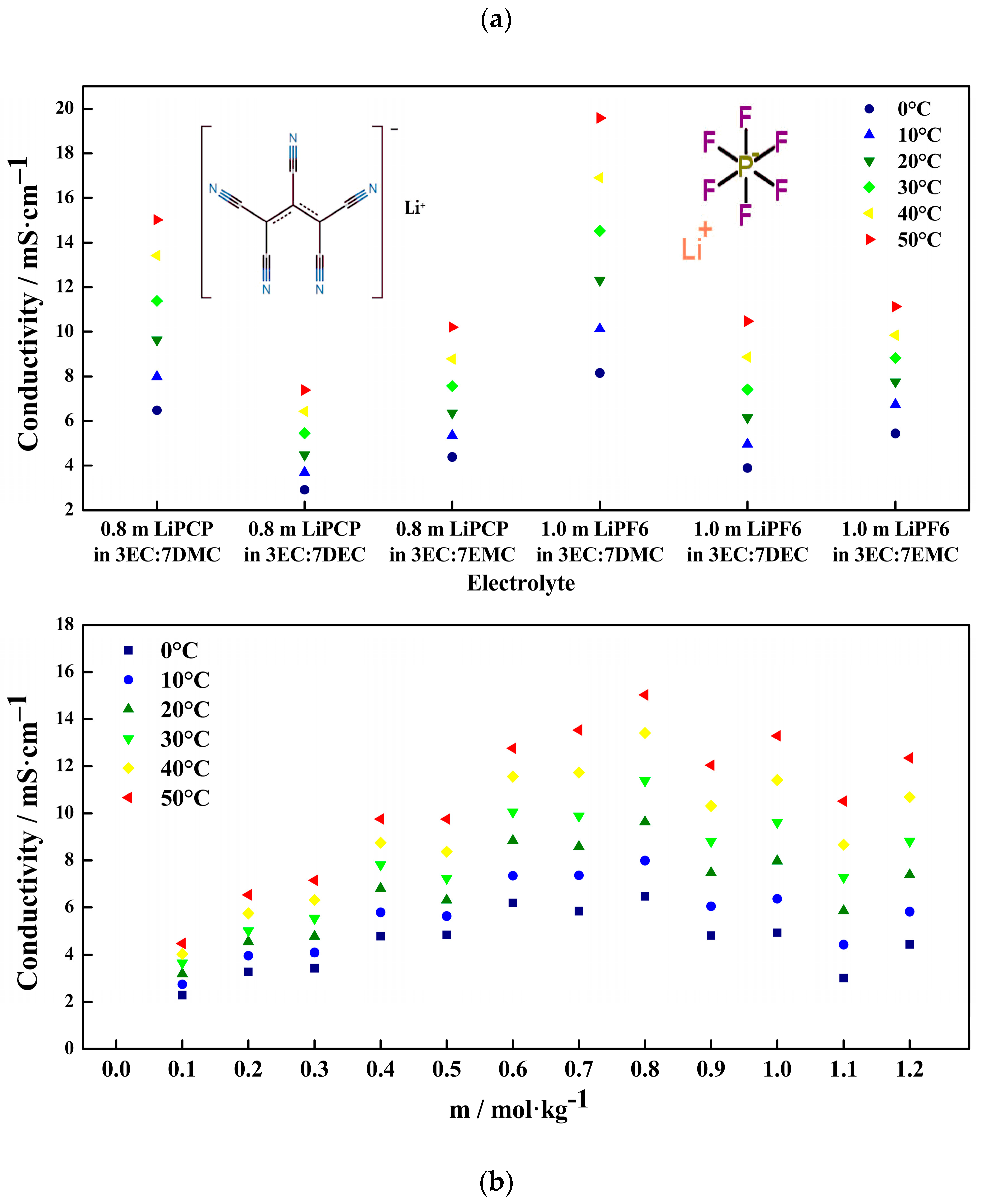
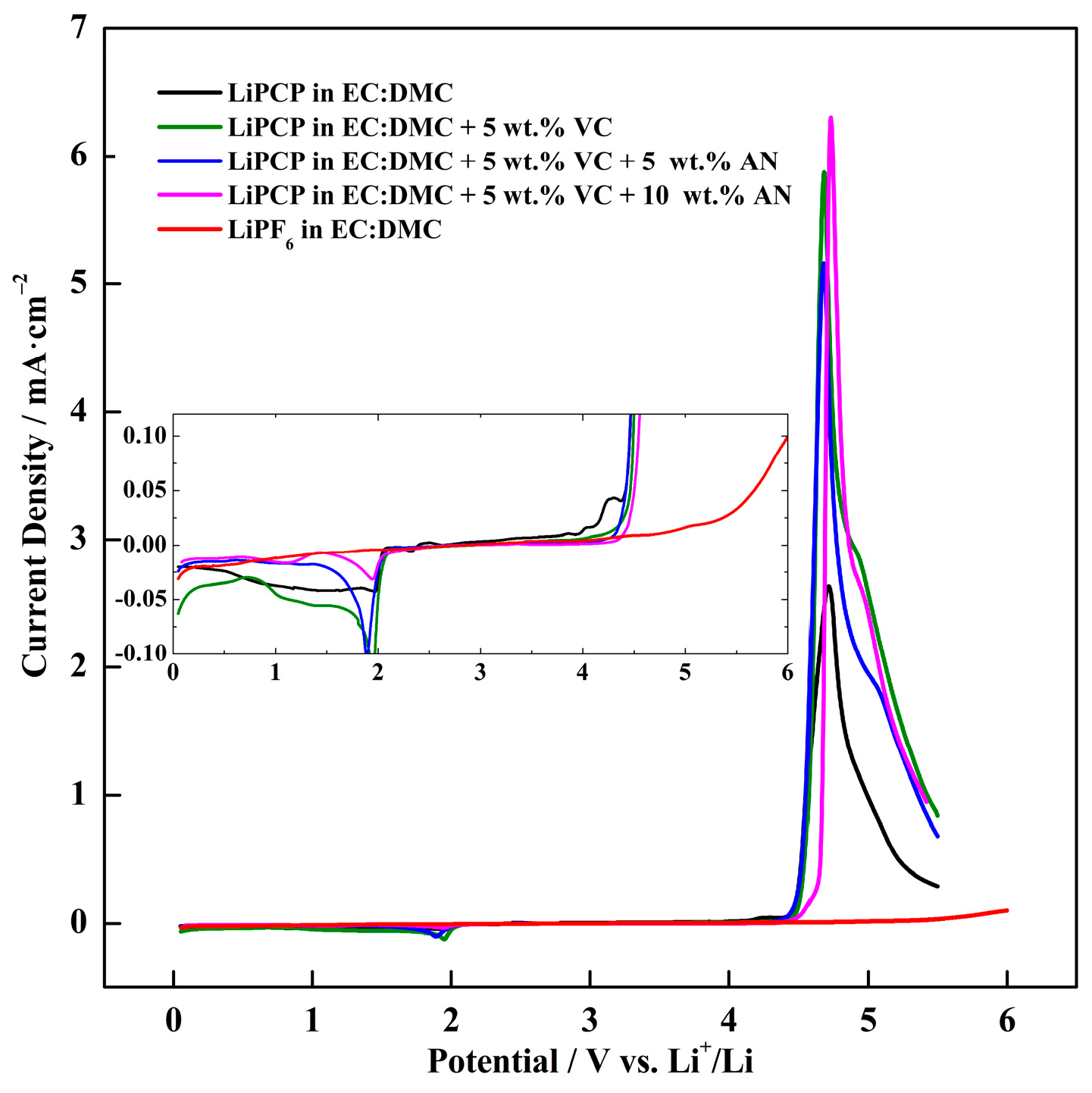
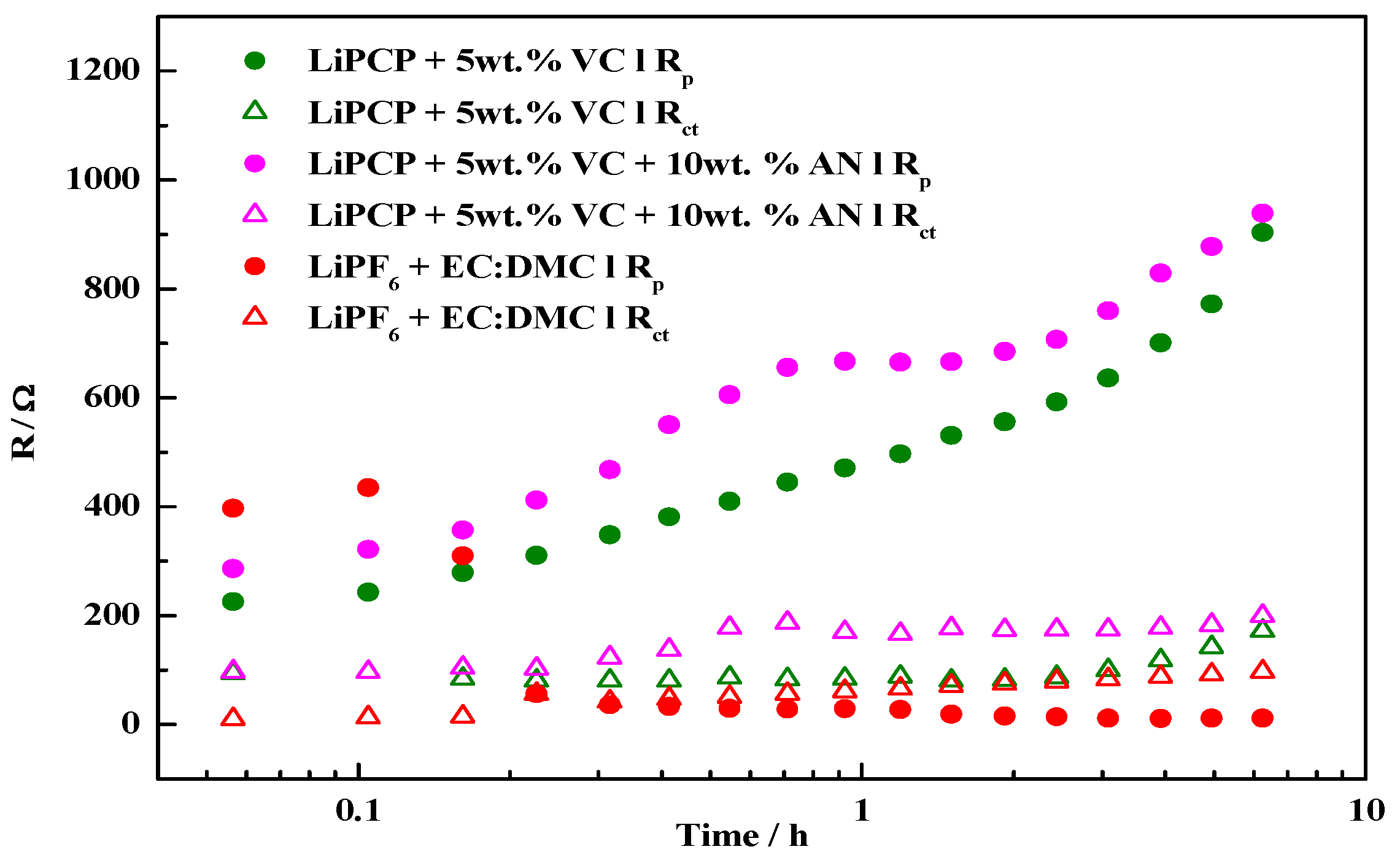
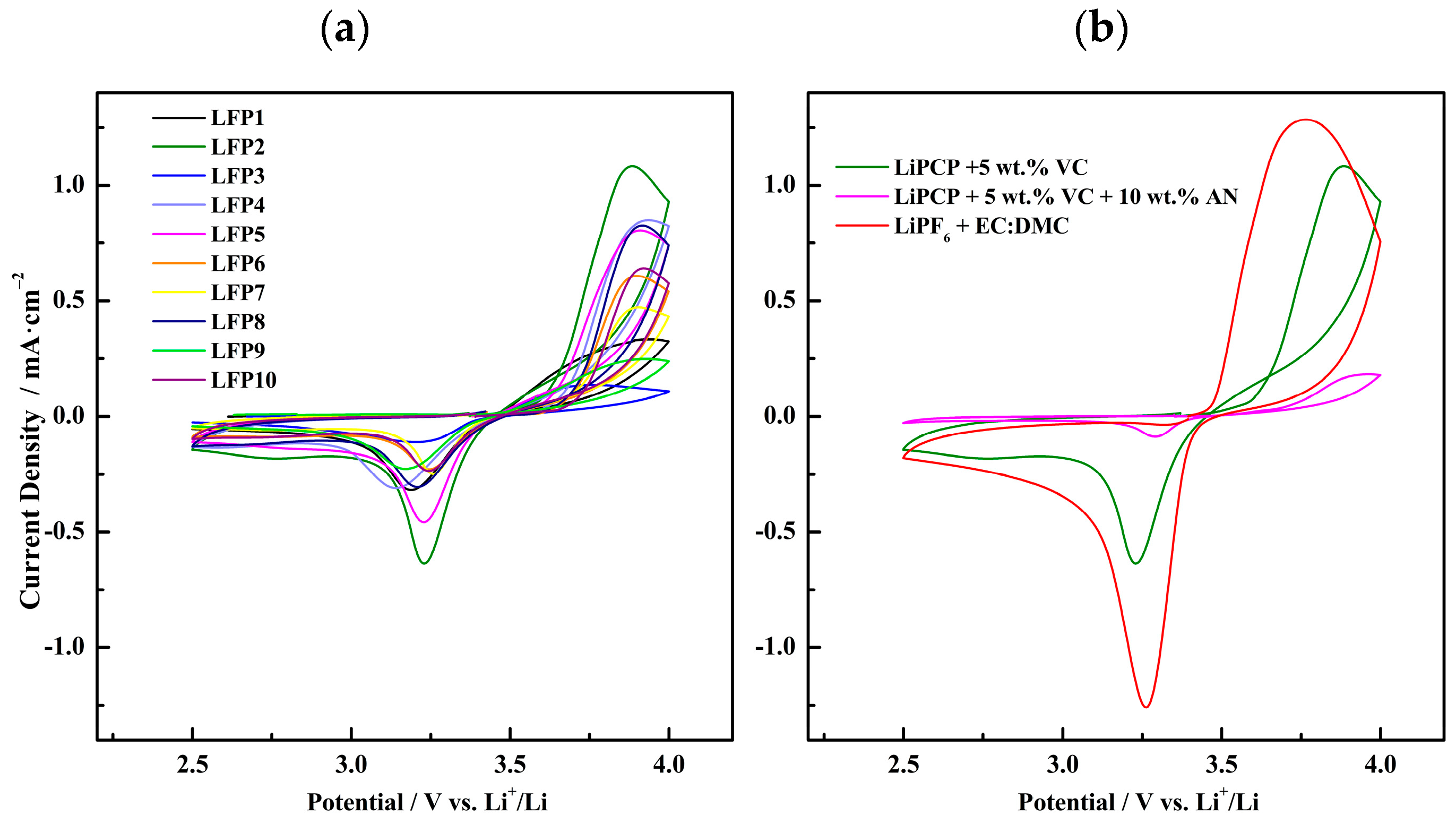
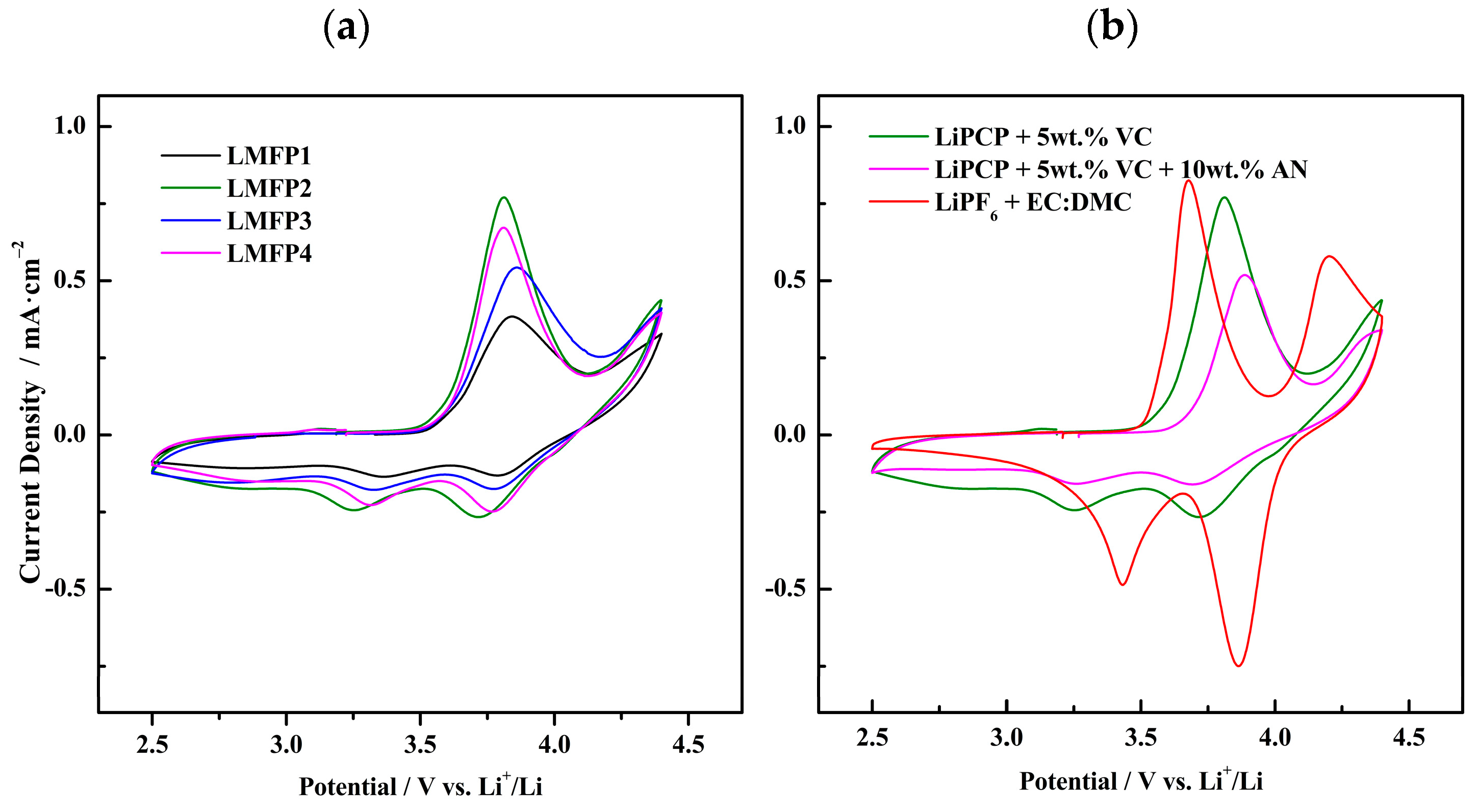
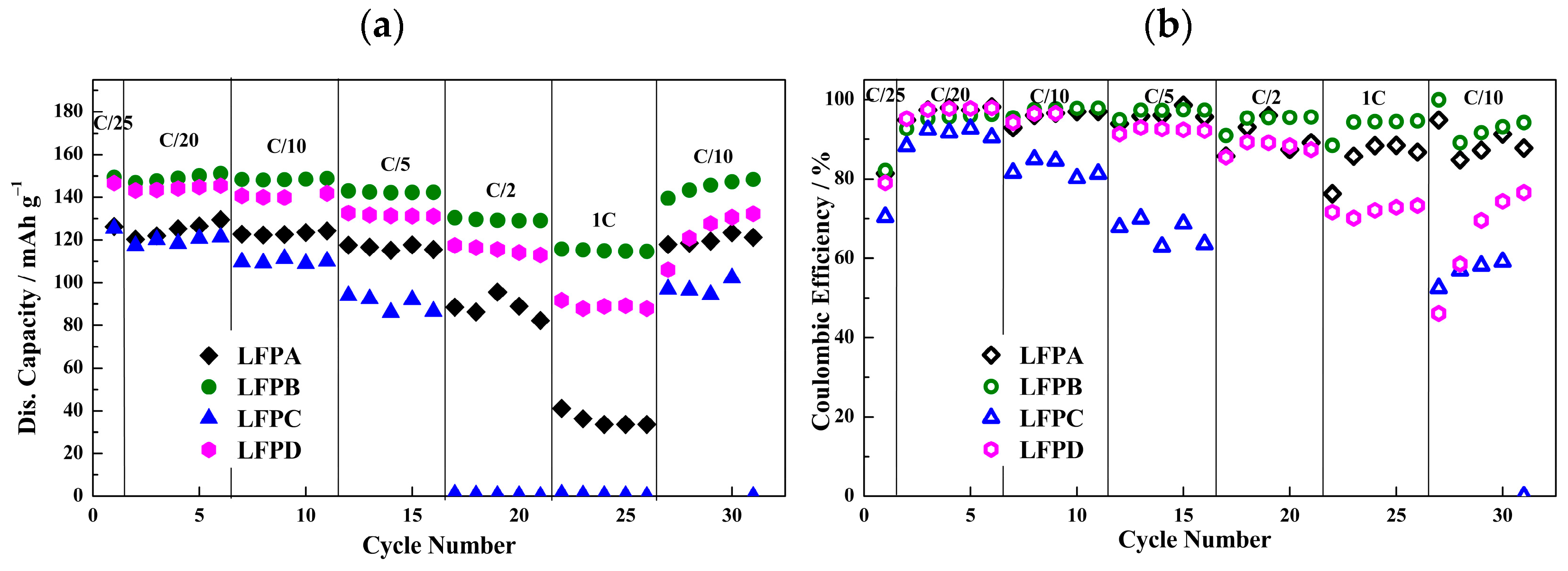
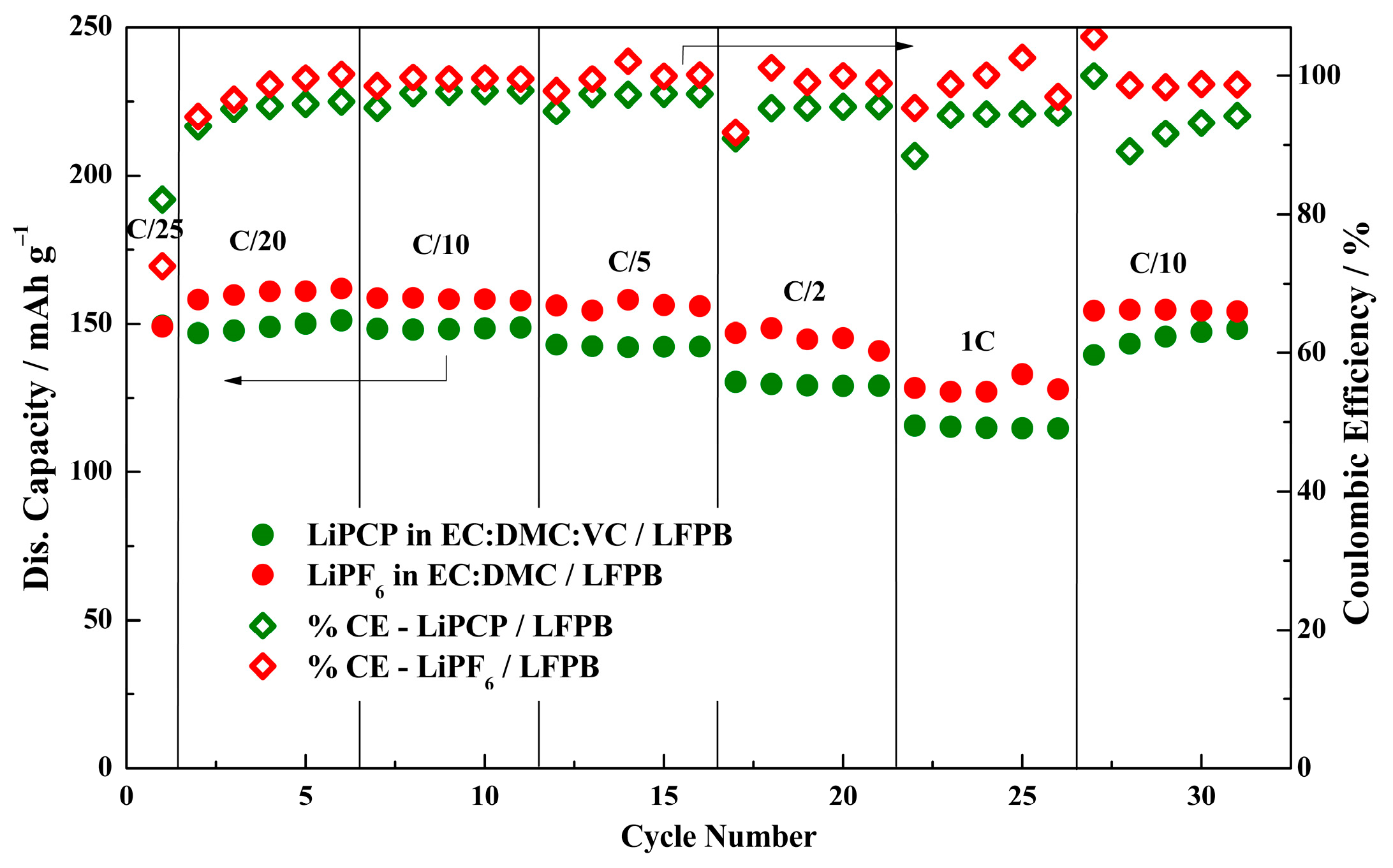




| Code | Active Material (AM)/wt.%, LFP | Conductive Material (CM)/wt.%, Super P | Binder/ wt.%, CMC | Oxidation Peak/V | Reduction Peak/V | ΔV/V | Discharge Peak Current Density/mA·cm−2 |
|---|---|---|---|---|---|---|---|
| LFP1 | 85 | 10 | 5 | 3.94 | 3.21 | 0.73 | 0.33 |
| LFP2 | 87 | 10 | 3 | 3.88 | 3.23 | 0.65 | 1.08 |
| LFP3 | 88 | 10 | 2 | 3.84 | 3.23 | 0.61 | 0.13 |
| LFP4 | 87.5 | 10 | 2.5 | 3.94 | 3.14 | 0.80 | 0.85 |
| LFP5 | 90 | 8 | 2 | 3.91 | 3.24 | 0.68 | 0.80 |
| LFP6 | 90 | 7.5 | 2.5 | 3.90 | 3.24 | 0.65 | 0.61 |
| LFP7 | 90 | 7 | 3 | 3.91 | 3.26 | 0.65 | 0.47 |
| LFP8 | 80 | 17 | 3 | 3.91 | 3.21 | 0.71 | 0.83 |
| LFP9 | 83 | 14 | 3 | 3.92 | 3.17 | 0.75 | 0.25 |
| LFP10 | 85 | 12 | 3 | 3.92 | 3.25 | 0.67 | 0.64 |
| Code | Active Material (AM)/ wt.%. LMFP | Conductive Material (CM)/wt.% | Binder /wt.% CMC | Conductive Material Carbon Black Type | Concentration CMC in Solution (wt.%) | Oxidation Peak/V | Reduction Peak/V | ΔV/V | Discharge Peak Current Density/mA·cm−2 |
|---|---|---|---|---|---|---|---|---|---|
| LMFP1 | 87 | 10 | 3 | Super P | 1.0 | 3.83 | 3.36 | 0.47 | 0.38 |
| LMFP2 | 87 | 10 | 3 | Ketjenblack EC600JD | 1.0 | 3.81 | 3.26 | 0.55 | 0.77 |
| LMFP3 | 87 | 10 | 3 | Super P | 1.5 | 3.86 | 3.33 | 0.53 | 0.54 |
| LMFP4 | 87 | 10 | 3 | Ketjenblack EC600JD | 1.5 | 3.81 | 3.32 | 0.49 | 0.67 |
| Code | Active Material (AM)/wt.% LFP | Conductive Material (CM)/wt.% | Binder /wt.% CMC | Conductive Material Carbon Black—Type | Concentration of CMC in Solution/wt.% |
|---|---|---|---|---|---|
| LFPA | 87 | 10 | 3 | Super P | 1.0 |
| LFPB | 87 | 10 | 3 | Ketjenblack EC600JD | 1.0 |
| LFPC | 87 | 10 | 3 | Super P | 1.5 |
| LFPD | 87 | 10 | 3 | Ketjenblack EC600JD | 1.5 |
| Experiment | Electrolyte | Observations |
|---|---|---|
| Ionic conductivity measurements | 0.1 to 1.2 mol·kg−1 LiPCP in EC:DMC (30:70 wt.%) | Screening of compositions at the temperature range of 0 °C to 50 °C |
| 0.8 mol·kg−1 LiPCP in EC:DMC (30:70 wt.%) EC:EMC (30:70 wt.%) EC:DEC (30:70 wt.%) | Comparison of conductivities of LiPCP and the most commercial electrolyte LiPF6 in different organic carbonate solvents | |
| 1 mol·kg−1 LiPF6 in EC:DMC (30:70 wt.%) EC:EMC (30:70 wt.%) EC:DEC (30:70 wt.%) | ||
| Linear sweep voltammetry | 0.8 mol·kg−1 LiPCP in EC:DMC (30:70 wt.%) 0.8 mol·kg−1 LiPCP in EC:DMC (30:70 wt.%) + 5 wt.% VC 0.8 mol·kg−1 LiPCP in EC:DMC (30:70 wt.%) + 5 wt.% VC + 5 wt.% AN 0.8 mol·kg−1 LiPCP in EC:DMC (30:70 wt.%) + 5 wt.% VC + 10 wt.% AN | Evaluating the electrochemical stability window |
| Lithium passivation | 0.8 mol·kg−1 LiPCP in EC:DMC (30:70 wt.%) + 5 wt.% VC 0.8 mol·kg−1 LiPCP in EC:DMC (30:70 wt.%) + 5 wt.% VC + 10 wt.% AN 1.0 mol·kg−1 LiPF6 in EC:DMC (30:70 wt.%) | Evaluating the lithium effect and effect in the cycling |
| Galvanostatic charge/discharge cycling | 0.8 mol·kg−1 LiPCP in EC:DMC (30:70 wt.%) | This composition was used for the cycling, compatibility, and stability evaluation |
Disclaimer/Publisher’s Note: The statements, opinions and data contained in all publications are solely those of the individual author(s) and contributor(s) and not of MDPI and/or the editor(s). MDPI and/or the editor(s) disclaim responsibility for any injury to people or property resulting from any ideas, methods, instructions or products referred to in the content. |
© 2024 by the authors. Licensee MDPI, Basel, Switzerland. This article is an open access article distributed under the terms and conditions of the Creative Commons Attribution (CC BY) license (https://creativecommons.org/licenses/by/4.0/).
Share and Cite
Limachi, C.; Rogala, K.; Broszkiewicz, M.; Cabello, M.; Niedzicki, L.; Armand, M.; Wieczorek, W. Development of Fluorine-Free Electrolytes for Aqueous-Processed Olivine-Type Phosphate Cathodes. Molecules 2024, 29, 4698. https://doi.org/10.3390/molecules29194698
Limachi C, Rogala K, Broszkiewicz M, Cabello M, Niedzicki L, Armand M, Wieczorek W. Development of Fluorine-Free Electrolytes for Aqueous-Processed Olivine-Type Phosphate Cathodes. Molecules. 2024; 29(19):4698. https://doi.org/10.3390/molecules29194698
Chicago/Turabian StyleLimachi, Claudia, Klaudia Rogala, Marek Broszkiewicz, Marta Cabello, Leszek Niedzicki, Michel Armand, and Władysław Wieczorek. 2024. "Development of Fluorine-Free Electrolytes for Aqueous-Processed Olivine-Type Phosphate Cathodes" Molecules 29, no. 19: 4698. https://doi.org/10.3390/molecules29194698







